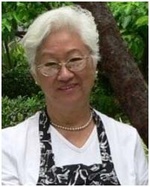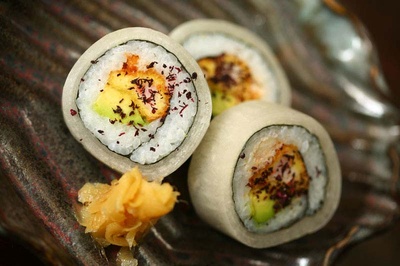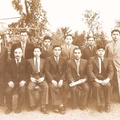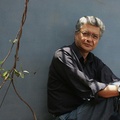>> First part
The beginning of the boom of Nikkei chefs and restaurants
At the end of the 20th century, several Nisei restaurants, such as “Costanera 700” by Humberto Sato, “Rosita” by Rosita Yimura ( – 2005), “Ah -gusto” by Augusto Kage, “La Buena Muerte” by Minoru Kunigami ( 1918- 2004) 1 , “Otani's meeting” and “Lobos de Mar” by the Otani Family, “Darío” by Darío Matsufuji, among others, achieved wide recognition that was not based only on popularity among their diners or clients. , but several of the Nikkei chefs began to be identified through the media (newspapers, magazines, television) and in this first decade of the new century the boom of Nikkei cuisine in Peru would become a significant part of the international boom as well. of Peruvian cuisine.
But, although it seems that the origin of Nikkei cuisine is found in homes of Japanese origin, especially when local and Japanese or Asian ingredients were brought together by replacement or simple experimentation, it is worth asking: how did this type of leap come about? from cooking to restaurants? According to the renowned Peruvian chef Gastón Acurio and the gastronomy researcher and journalist Mariella Balbi (both authors of books on the subject), the pioneer of Peruvian Nikkei cuisine was Minoru Kunigami, Nisei and son of an immigrant from Okinawa, also dedicated to manage a Creole food restaurant.
Minoru Kunigami opened a restaurant specializing in fish and seafood in Cercado de Lima at the end of the 1960s and, although the original name was different, the public baptized it “La Buena Muerte” because it was located on the street with that name. . Its success was such that it prepared 100 kilos of fish a day and, according to Acurio, “it played a fundamental role in our local gastronomy,” because it contributed to spreading the consumption of marine products in Lima, among an unaccustomed public. to them 2 .
In fact, according to Balbi, despite the fact that the Peruvian sea had 2,319 species, between the 1930s and 1970s the middle and upper classes only consumed sole and corvina plus three additional species, partly out of fear of their decomposition due to lack of refrigeration and also due to ignorance. “Japanese immigrants and their children enjoyed our marine delicacies before Peruvians,” says Balbi 3 . To this we should add that the love for the sport of fishing (in rocks and beaches on the Peruvian coast) among Japanese immigrants and their descendants from very early times allowed them to bring seafood home with regular frequency.
However, the adoption of some policies by the military government of General Juan Velasco Alvarado (1968-1975), such as decreeing a ban on the sale of beef for 15 days a month, produced a change in the general diet and - according to Balbi - fish consumption became widespread since the 1970s. Cevicherias or restaurants specialized in the preparation of ceviche – for the majority today, the national dish 4 – appeared in those years.
And in the preparation of ceviche there is also a certain consensus on the Nikkei contribution: “Nikkei cooks served the ceviche 'al dente', prepared on the spot. Peruvian cuisine, on the other hand, had the rule of marinating it in lemon for three hours and the meat had to be fully cooked. But the raw ceviche prevailed, now no one thinks of leaving it for that long and the freshness of the fish is savored more.” 5

Cover of the bilingual book, dedicated to the cuisine of Rosita Yimura, published by editor Johnathan Cavanagh in 1995. Lima, Bogotá: Peru Reporting EIRL (left); Cover of the book by Mariella Balbi, published by the San Martín de Porres University. Lima, 1997. (right)
The future of Nikkei cuisine
Gastón Acurio , in addition to being a professional chef, is a young and successful businessman, owner of several chains of Peruvian cuisine restaurants in Lima and in other countries, he is also one of the most admired and recognized Peruvian characters in his own country, and the greatest promoter of Nikkei cuisine. Addressing the Nikkei chefs, he reflects and proposes:…..“Nikkei cuisine is Peruvian cuisine with Japanese influence, not Japanese cuisine with Peruvian influence…. The primary ingredient of a Nikkei cuisine must always be the sea... Nikkei cuisine made by Nikkeis is much tastier... Long live Nikkei cuisine! It is neither better nor worse than Japanese cuisine, but different... Japanese pride, so important to their nation, sometimes makes some of their descendants reluctant to call their cuisine 'Nikkei', believing that this makes it of lower quality than that of their parents. Let's banish that forever. One thing is Japanese cuisine – delicious, refined, admirable – and another is Peruvian-Japanese Nikkei cuisine – tasty, fun, mischievous…..To go out into the world it has been said…..If Nobu Matsuhisa 6 could do it, why our Nikkei cooks won't be able to? If he has already proven that the world loves this cuisine, then what are they waiting for to go out and conquer the big cities? Dear Nikkei friends, success is assured. “The time has come to go out and succeed.” 7
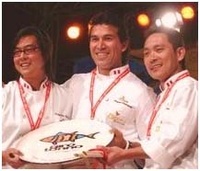
Young Nikkei chefs: Diego Oka (“La Mar”), Hajime Kasuga (“Hanzo”). Source: Peruvian-Japanese Association.
For Toshiro Konishi - a Japanese chef who arrived in Peru in 1974 to work at the restaurant “Matsuei, together with Nobu Matsuhisa – Nikkei cuisine “is very rich, but it is being limited. It's fine to prepare fish and seafood, but if your marriage has a good foundation, why not make dishes with chicken, pork or beef. In the kitchen there are no limitations. Nikkei cuisine is still a baby” (cited by Balbi, in 1997).
To these two valuable opinions one could add that the Nikkei practice and prepare various types of cuisine and food in the present, just as in the past in Peru, and will probably continue with this vocation for restaurants in the future. As a former Japanese immigrant, the owner of a restaurant in the 1940s in Lima, stated about why he decided to open a business of this type: “with a restaurant you run a risk like in any business, it may not be possible.” earn money, but you ensure the feeding of a large family, the food is not lost. It is useful for bad times and good times” (K. Hayashi).
At present, it seems that some of the Creole restaurants of Nikkei owners continue to be successful, such as that of the Yamakawa family in the Surquillo market area, as well as the “Hikari” restaurant chains and the “Norki's” chicken shops. and “Rocky's” in most districts of Lima. Likewise, Peruvian sandwich establishments, such as the “Palermo” chain with the specialty in country ham and “Kyo's” with the specialty in chicharrones, both made of pork, are recognized for their large clientele in the preparation of traditional Peruvian stews. in the cafeterias or “sangucherías” category.
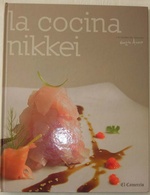
Cover of the book by Gastón Acurio “The Nikkei Kitchen”, Volume 4 of the Kitchens of Peru Collection, 2006.
On the other hand, the international “boom” of sushi, in its most Westernized version with the addition of unusual ingredients in the traditional style, such as cream cheese and various sauces, also arrived in Peru and, with it, specialized restaurants multiplied. and its consumption among middle and high sectors, previously alien to Japanese food and also in the use of chopsticks or ohashi.
Among the new Nikkei restaurants, it is increasingly difficult to establish a classification, whether it is Japanese cuisine or traditional Nikkei cuisine, and – despite the repetition in the new types of sushi and maki – some culinary creations suggest a tendency towards appearance of signature cuisines, at least among young chefs dedicated to study and experimentation, just as the most important figures of the now traditional Nikkei cuisine did at the time. Among the latter: Rosita Yimura, recognized as the creator of “Octopus al olivo” and Humberto Sato for his “Chita a la sal”. For both of them, with a shared humility, their creations were destined to please customers and above all to win friends 8 .
Among the new Nikkei chefs, Hajime Kasuga (Restaurant “Hanzo”), Mitsuhara Tsumura (Restaurant “Maido”), Omar Frank Maruy (Restaurant Nikko”), among others, are beginning to stand out. Their art and creations have already made them representatives of Peruvian cuisine in its Nikkei version on various international stages and it is also common to see them on cooking and journalistic programs on local television.
Finally, both for young Nikkei and for Peruvians in general, the success of local chefs – including several Japanese surnames – is serving as a reason for choosing careers as chefs and the like. Along with this revaluation of the chef profession, numerous specialized schools and institutes have been opened, some within universities, and also every day a new restaurant appears in Lima, Cusco and other places in Peru, with different proposals and oriented in much of it to external tourism, which essentially constitutes new sources of jobs for our youth.
Grades:
1. The birth and death data of Rosita Yimura and Minoru Kunigami are based on information from the book by: Acurio, Gastón. 2006. The kitchens of Peru. Volume 4: Nikkei cuisine . Lima: El Comercio Publishing Company; 184 pp.
2. Acurio; p. 51-52.
3. Balbi, Mariela. 1997. The kitchen according to Sato . (Satos's Cooking Nikkei- Style Fish and Seafood”. Lima: Universidad San Martín de Porres, Faculty of Tourism and Hospitality, 161 pp, Spanish-English; pp. 21-22.
4 Ceviche is made with fish (also shellfish and even mushrooms), marinated in sour lemon juice, salt, pepper and chili, sometimes also with garlic and served with julienned onions, corn (Peruvian corn) and sweet potato.
5. Balbi, p. 24.
6. Successful Japanese chef who came to Peru in the 1970s to work at the Matsuei Restaurant, years later he went to the United States and today is co-owner of a restaurant chain (Nobu and Matsuhisa) in Los Angeles, New York, Milan , London, whose cuisine is promoted as Peruvian-Japanese.
7. Acurio; pp. 82, 102, 103, 118, 155.
8. See books dedicated to the kitchens of both, by Mariella Balbi and The Peru Reporting.
* This article is published under the San Marcos Foundation Agreement for the Development of Science and Culture of the Universidad Nacional Mayor de San Marcos - Japanese American National Museum, Discover Nikkei Project. 2009- 2010. Lima- Perú, April 2010/Amelia Morimoto, editor and coordinator.
© 2010 Amelia Morimoto


